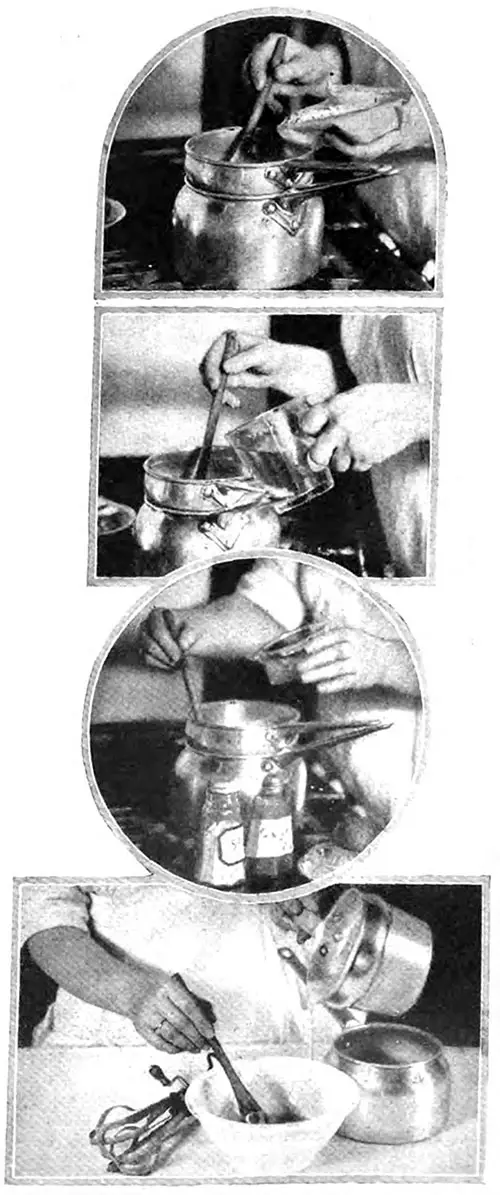Measuring and Mixing

Mixing the Ingredients for Hollandaise Sauce © 1920 Good Housekeeping
Half of the secret of good cooking lies in accurate measurement. Good Housekeeping Institute recommends a standard measuring-set. First in its list of measuring-utensils are two standard measuring-cups holding one-half pint each and divided into quarters and thirds.
These may be made of either aluminum or glassware. The tin cup is too short-lived. A' set of accurate measuring-spoons is essential. These are made of aluminum and can be found in capacities graduated from one tablespoonful down to one-fourth teaspoonful. They assure uniform good results in baking-powder mixtures, cakes, and so forth, as well as careful seasoning.
A small spatula for the leveling of all solid measurements is indispensable. An aluminum quart measure and a small compact spring scale may also be added to the measuring equipment.
Use the scale more for checking the weights as purchased than for cooking by weight. A spring scale, while illegal in certain states because it can be easily tampered with, is nevertheless practical and accurate for household usage.
In all measuring see that the ingredients are level. A cupful is measured level; a tablespoonful is measured level; a teaspoonful is measured level. In measuring dry ingredients by the cupful fill the cup by tablespoonfuls, allow it to heap slightly, then level with a quick stroke of the spatula.
When fractions of a cupful are to be measured, measure by tablespoonfuls in preference to the use of the cup up to one- half cup capacity, remembering that sixteen tablespoonfuls are equal to one cupful. And do not shake the cup while filling.
To Measure Dry Ingredients
In measuring dry ingredients by the spoonful fill the spoon by dipping into the ingredient until more than level; level with the spatula, cutting with the edge of the knife toward the tip of the spoon.
For the half-teaspoonful, measure in exactly the same way, using the measuring spoon of one-half teaspoonful capacity. For the half-tablespoonful we the spoons of one teaspoonful and one-half teaspoonful capacity.
For one-eighth of a teaspoonful measure one-fourth teaspoons as usual, then cut sharply in two with the spatula. Less than one-eighth of a teaspoonful is called a “speck” or “a few grains” and is the amount which can be taken up on the very tip end of a vegetable knife. This is a term quite frequently used for seasoning.
In measuring a solid fat pack solidly into cup or spoon and cut level with the spatula. When one-quarter cupful or less of a fat is desired always measure in tablespoon fuis, allowing four tablespoonfuls to each quarter cupful.
Here is a simple way of measuring fats when less than one cupful is desired. If, for instance, one-half cupful of fat is desired, fill the measuring cup with one-half cupful of water and then add the fat in small pieces until the water reaches the cupful mark; then pour off the water and one-half cupful of fat will remain.
To Measure Liquids
In measuring liquids by the cupful pour the liquid to be measured into the cup, filling it to the very top of the standard cup. For fractions of cups fill in like manner to the indicated division. In the same way measure liquids by spoons, by taking up all the spoon will hold.
Just How to Mix
Fully as important as measuring is the correct motion for combining ingredients. These involve three processes, stirring, beating, and “cutting'’ or folding in. The stirring motion is required to blend ingredients together. It is the one that is most often employed for thoroughly mixing the ingredients of a dish.
Beating is the motion necessary when air must be introduced into a mixture in order to leaven it. In beating, the ingredients must be turned over and over, continually bringing the under part upward to the surface and consequently bringing with it, with each stroke, a certain amount of air.
The cutting; and folding motion is necessary when a mixture already containing entrapped air introduced by beating must have added to it an ingredient, also well beaten, and the mixing accomplished without loss of air from either mixture. The best illustration of this is a sponge cake where, into the light yolk-sugar-and-flour mixture, must be cut and folded the beaten egg-whites.
Briefly, by stirring, a dish is properly mixed; by beating, air is entrapped in the mixture; by cutting and folding, this air which has been already entrapped is prevented from escaping.
